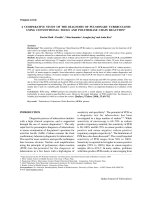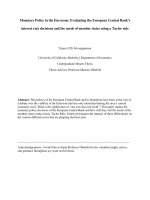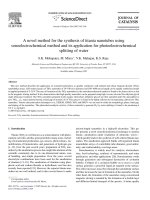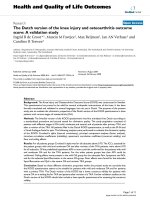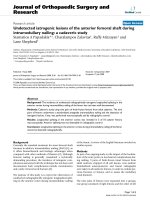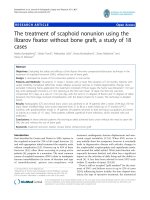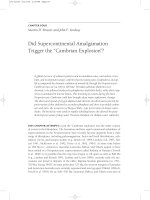the ecology of blue-crowned manakins (lepidothrix coronata) a comparison study of biometric sexing using discriminant analyses
Bạn đang xem bản rút gọn của tài liệu. Xem và tải ngay bản đầy đủ của tài liệu tại đây (6.19 MB, 67 trang )
Glasgow Theses Service
Aulicky, Carly (2014) The ecology of blue-crowned manakins
(Lepidothrix coronata): a comparison study of biometric sexing using
discriminant analyses. MSc(R) thesis.
Copyright and moral rights for this thesis are retained by the author
A copy can be downloaded for personal non-commercial research or
study, without prior permission or charge
This thesis cannot be reproduced or quoted extensively from without first
obtaining permission in writing from the Author
The content must not be changed in any way or sold commercially in any
format or medium without the formal permission of the Author
When referring to this work, full bibliographic details including the
author, title, awarding institution and date of the thesis must be given
! ! "!#$%&'!()&*+,'! /01/ !
!
The Ecology of Blue-crowned Manakins (Lepidothrix coronata)
A Comparison Study of Biometric Sexing Using Discriminant
Analyses
!
!
!
!
!
Carly Aulicky
1109256a
August 2013
A thesis submitted to the Postgraduate School College of Medical, Veterinary
and Life Sciences in fulfilment of the requirements for a Masters of Science by
Research Ecology, University of Glasgow
Written under the direction of
Dr Stewart White
Institute of Biodiversity, Animal Health and Comparative Medicine
!
!
!
()&*+,'!2!
Abstract
!
Blue-crowned manakins (Lepidothrix coronata) exhibit neotenic retention of subadult
monomorphic plumage in sexually mature males. Definitively plumaged adult L. coronata
are dichromatic, with males displaying a black body and blue crown while females retain
green colouration characteristic of Pipridae species. Male neoteny and the reliance on soft
tissue colouration to identify females make mature monomorphic L. coronata
indistinguishable in the field, presenting research and management difficulties. The
application of biometric measurements with discriminant function analysis (DFA) offers a
practical methodology to sex L. coronata. Three DFA methods were compared using L.
coronata of definitive plumage and known sex to determine the best modelling methodology
for future applications. A linear discriminant analysis was performed using biometric
measurements and combined with a principal component analyses. Quadratic discriminant
analysis was performed using biometric measurements as a comparison to linear
methodologies. Linear and quadratic discriminant analyses of biometric measurements
produce a 92.86 and 91.2 per cent accuracy sexing definitively plumaged L. coronata,
indicating applicability of statistical modelling as a potential solution for future field
applications.
!
! !
!
()&*+,'!-!
Acknowledgements
!
I would like to acknowledge my advisor Dr Stewart White, who has patiently answered my
questions, provided sound advice, and introduced me to research in San José de Payamino. I
would like to express my appreciation to Dr Richard Preziosi of the University of Manchester
for being amazingly considerate and helpful. I would like to thank the University of Glasgow
2012 Ecuador Expedition Crew for their assistance in the collection of my data. I would
especially like to offer my appreciation for the numerous groups and individuals who
contributed data to the Payamino Project, without whom this research would not have been
possible. I am particularly grateful for the assistance and support of the Timburi Cocha
Scientific Research Station and the community of San José de Payamino, who continue to
support and invest in scientific research. I would like to offer my special thanks to the US-
UK Fulbright Commission for endorsing my studies at the University of Glasgow and for
facilitating one of the best years of my life.
!
()&*+,'!3!
Table of Contents
ABSTRACT' '2!
(#456789:;9<95=>!?????????????????????????????????????????????????????????????????????????????????????????????????????????????????????????????!-!
TABLE'OF'CONTENTS' '4!
LIST'OF'FIGURES' '5!
LIST'OF'TABLES' '6!
SECTION'1:'INTRODUCTION ' '7!
SECTION'2:'MATERIALS'AND'METHODS' '21!
2?.!>=@:A!>B=9!????????????????????????????????????????????????????????????????????????????????????????????????????????????????????????????????????!2.!
2?2!>(<C8B5;!<9=D6: !????????????????????????????????????????????????????????????????????????????????????????????????????????????????????????!2.!
2.2.1$Mist$Net$Sampling$ $21!
2.2.2$Biometric$Measurements$ $23!
2?-!(5(8A>B>!<9=D6:686;A!????????????????????????????????????????????????????????????????????????????????????????????????????????????????!23!
2.3.1$Software$ $24!
2.3.2$Data$Preparation$ $24!
2.3.3$Sexual$Size$Dimorphism$Calculation$ $25!
2.3.4$Tree$Analysis$ $26!
2.3.5$Discriminant$Function$Analysis$ $27!
SECTION'3:'RESULTS' '29!
-?.!>9E@(8!>BF9!:B<6GC D B> <!???????????????????????????????????????????????????????????????????????????????????????????????????????????????!2H!
-?2!#8(>>BIB#(=B65!=G99!(5(8A>B>!?????????????????????????????????????????????????????????????????????????????????????????????????????????!-0!
-?-!:B>#GB< B5 ( 5 = !I@5#=B65!(5(8A>B>!#6<C(GB>65!???????????????????????????????????????????????????????????????????????????????! !
SECTION'4:'DISCUSSION' '35!
SECTION'5:'CONCLUSION' '39!
BIBLIOGRAPHY' '42!
APPENDICES' '53!
(CC95:BE!(J!(:@8=!:(=(!?????????????????????????????????????????????????????????????????????????????????????????????????????????????????????!K-!
(CC95:BE!LJ!B<<(=@G9!:(=(!???????????????????????????????????????????????????????????????????????????????????????????????????????????????!KK!
(CC95:BE!#J!CB86= !8B59(G!:B>#GB<B5 ( 5 = !<6:98!6I!LB6<9= G B# >!??????????????????????????????????????????????????????????????!KM!
(CC95:BE!:J!CB86= !8:( !<6:98!6I!CGB5#BC(8!#6<C6595=>!?????????????????????????????????????????????????????????????????????!N.!
(CC95:BE!9J!CB86= !O@(:G(=B#!:B>#GB< B5 ( 5 = !<6:98!??????????????????????????????????????????????????????????????????????????????!NK!
!
!
()&*+,'!K!
List of Figures
!
FIGURE 3.3.1: DISTRIBUTION OF ASSIGNED INDIVIDUAL DISCRIMINANT SCORES BY LDA MODEL!????????????????????????! !
FIGURE C1: HISTOGRAM OF DISCRIMINANT SCORE DISTRIBUTIONS PILOT BIOMETRICS LDA MODEL!???????????????????!K1!
FIGURE C2: VARIABLE ERROR ASSOCIATED WITH BIOMETRIC MEASUREMENTS IN A BIOMETRICS LDA MODEL!???!KH!
FIGURE D1: HISTOGRAM OF DISCRIMINANT SCORES OF LDA/PCA MODEL!??????????????????????????????????????????????????????????!N2!
FIGURE D2: PARTITION PLOTS OF THE PILOT LDA/PCA MODEL!???????????????????????????????????????????????????????????????????????????!N3!
FIGURE E1: PARTITION PLOT OF PILOT OF THE QDA MODEL!????????????????????????????????????????????????????????????????????????????????!NN!
!
!
!
!
!
!
!
!
!
!
!
!
()&*+,'!N!
List of Tables
!
=(L89!-?.?.J!#(8#@8(=9:!(:@8=!>9E@(8!>BF9!:B<6GCDB><!B5:9E!G(=B6!LA!LB6<9=GB#!P(GB(L89!??????????????????????????????????????????!-0!
=(L89!-?-?.!#6<C(GB>65!6I!:B>#GB<B5(5=!(5(8A>9>!I6G!(##@G(#A!(5:!>=(LB8B=A!???????????????????????????????? ??????????????????????????!-2!
=(L89!-?-?2!LB6<9=GB# > !: ( =( !6 I !L.$CORONATA$<B>#8(>>BIB9:!LA!:I(!<6:98!??????????????????????????????????????????????????????????????????!-3!
=(L89!#.J!<(=@G9!L.$CORONATA$(>>B;5<95=!=6!>9E!#(=9;6GA!8:(!LB6<9=GB#>!?????????????????????????????????????????????????????????????!KM!
=(L89!#2J!8:(!LB6<9=GB#!#8(>>BIB#(=B65!7B=D!89(P9!659!6@=!#G6>>QP(8B:(=B65!???????????????????????????????????????????????????????????!N0!
=(L89!:.J!P(GB(=B65!6I!(:@8=!LB6<9=GB#>!9EC8(B59:!LA!CGB5#BC(8!#6<C6595=>!????????????????????????????????????????????????????????????!N.!
=(L89!:.J!#8(>>BIB#(=B65!CB86=!8:( /C#(!<6:98!??????????????????????????????????????????????????????????????????????????????????????????????????????!N2!
=(L89!:2J!#G6>>QP(8B:(=9:!#8(>>BIB#(=B65>!CB86=!8:(/C#(!<6:98!?????????????????????????????????????????????????????????????????????????????!N3!
=(L89!9.J!CG9:B#=9:!>9E!6I!CB86=!O:(!<6:98!???????????????????????????????????????????????????????????????????????????????????????????????????????????!NK!
=(L89!92J!#G6>>QP(8B:(=9:!#8(>>BIB#(=B65!CB86=!O:(!<6:98!??????????????????????????????????????????????????????????????????????????????????????!NN!
! !
!
()&*+,'!M!
Section 1: Introduction
Sexual selection was presented by Charles Darwin in The Descent of Man, and
Selection in Relation to Sex (1871) as an explanation for the existence of secondary sexual
characteristics. Secondary sexual characteristics are adaptations that increase intrasexual
competitive advantage but may not aid negotiation of the environment or increase the
likelihood of survival (Molles Jr. 2009; Campbell et al. 1999; Clutton-Brock 2007;
Andersson 1994a). Sexual selection mechanisms act to maximise breeding potential by
increasing access to mates or by increasing mate attraction. Favoured secondary sexual
characteristics and behaviours are continued in offspring and contribute to the gene pool as
aspects of fitness.
Ecological pressures for sexual selection increase with gender limitations on the
energetic investment in reproduction and the intensity of intrasexual competition for breeding
(Owens & Thompson 1994; Clutton-Brock 2007; Andersson 1994a). Female selection
increases male variation due to breeding competition for the limited number of fertile females
(Owens & Thompson 1994; Clutton-Brock 2007; Andersson & Iwasa 1996). Male selection
occurs where variations in female reproduction are increased and there are fitness advantages
in mate selection (Clutton-Brock 2007; Clutton-Brock 2009).
Mechanisms of sexual selection include pre-copulation competition, fitness
advertisement, and post-copulation competition (Andersson & Iwasa 1996; Clutton-Brock
2007; Andersson 1994a; Johnson & Burley 1998). In avian species pre-copulation sexual
selection mechanisms include fitness advertisement through plumage colouration, ornamental
feathers, song, building infrastructure, and sexual size dimorphism (Clutton-Brock 2007;
Owens & Hartley 1998; Owens & Thompson 1994; Andersson & Iwasa 1996). Post-
copulation selection mechanisms include sperm competition and female sperm selection
!
()&*+,'!1!
(Dean et al. 2011; Briskie & Montgomerie 1993; Lifjeld et al. 1994; Møller & Ninni 1998;
Andersson & Iwasa 1996). Avian species may present multiple secondary sexual
characteristics applicable to particular aspects of intrasexual competition or mate attraction
(Møller & Pomiankowski 1993; Pryke et al. 2001).
Plumage colouration in avian species is an indication of mate quality in both sexes,
where bright colouration, elaborate patterns, or ornamentation signal mate fitness (Hill 1993;
Stein & Uy 2006; Doucet 2002; Gomez et al. 2013). The brightness of feather colouration is
an indicator of offspring fitness, the number of offspring, and the ability to provide paternal
care in socially monogamous species (Siefferman & Hill 2005; Balenger et al. 2009;
Siefferman & Hill 2003; Møller & Birkhead 1994). In bluebirds (Sialia spp.), the brightness
of feathers is an indication of foraging abilities. Pigmentation formed during moult is affected
by the quantity and quality of food, with consistent feeding reflected in brighter plumage
(Siefferman & Hill 2005; Siefferman & Hill 2003; Balenger et al. 2009).
Contrast in plumage patterns is hypothesized by Hasson (1991) to be a mechanism to
accentuate feather contour and wear by allowing the edges of feathers to be distinctive.
Feather glossiness and pattern can emphasise contour and low wear, indicating foraging
capabilities and overall quality of feather structure (Hasson 1991; Fitzpatrick 1998). Plumage
brightness in male passerines can also reflect immunocompetence and resistance to
endoparasites and viruses (Hamilton & Zuk 1982; Hamilton & Poulin 1997; Pruett-Jones et
al. 1990; Lindstrom & Lundstrom 2000).
Plumage ornamentation in males and females acts as an advertisement of genetic
quality, mate fitness, and capacity for parental investment (Møller 1993; Amundsen 2000;
Saino et al. 1997; Winquist & Lemon 1994). Ornamental plumage is most common in males,
where ornaments may also be utilised in intrasexual competition to assert dominance (Pryke
!
()&*+,'!H!
et al. 2001; Andersson & Andersson 1994). In species with long retrice feathers, an extensive
tail is a highly visible indication of male fitness to competitive males and potential mates
(Pryke et al. 2001; Møller & Pomiankowski 1993).
Male tail length is positively correlated with the number of fathered offspring in
social and extra-pairings. Ornamental retrice feathers of the male barn swallow (Hirundo
rustica) have also been linked to an increased female reproductive input (Møller 1991; de
Lope & Møller 1993). Adaptation of long tail plumage by males can act to accentuate
mobility to females when combined with display (Byers et al. 2010). Ornament condition,
especially feather length, displays resistance to parasites and has been correlated to lower
infection of feather mites and endoparasites (Hoglund et al. 1992; Höglund & Sheldon 1998;
Møller 1990).
The duration, frequency, and complexity of songs are a mechanism of intrasexual
competition and intersexual mate attraction in some avian species. Song and auditory
displays signify genetic quality and mate endurance is associated with high song frequency or
complexity (Searcy 1992; Searcy & Andersson 1986; Catchpole 1987). The complexity and
duration of songs in the European starling (Sturnus vulgaris), the common whitethroat (Sylvia
communis), and aquatic warbler (Acrocephalus paludicola) are correlated to increased female
selection (Eens et al. 1991; Catchpole & Leisler 1996; Balsby 2000). The frequency and
complexity of responses to competitor song serve as a method of claiming dominance,
securing territories, and increasing mate access in intrasexual competition (Searcy &
Yasukawa 1990). The ability to produce frequent, complex songs is also an indication of
healthiness and resistance to parasitic infections (Redpath et al. 2000; Catchpole & Leisler
1996; Hamilton & Zuk 1982; Gilman et al. 2007).
!
()&*+,'!.0!
Avian species such as the ruffed grouse (Bonasa umbellus), Calypte genus of
hummingbirds and the club-winged manakin (Machaeropterus deliciosus) also utilise
sonation or mechanical noise in intrasexual competition and intersexual selection (Feo &
Clark 2010; Bostwick & Prum 2003; Prum 1998; Clark 2008; Samuel et al. 1974; Clark &
Feo 2010). Sonation produced by moving wing or tail feathers is a common component of
Neotropical species mate attraction (Feo & Clark 2010; Bostwick & Prum 2003; Bostwick
2000; Prum 1998; Clark 2008). Mechanical noise such as drumming by downy woodpeckers
(Picoides pubescens) and wing popping in the Pipra genus of Pipridae also serve as a method
of asserting dominance in intrasexual competition (Bostwick 2000; Prum 1998; Kilham
1974a; Kilham 1974b).
The construction of nests or elaborate bowers is a courtship mechanism employed by
male bowerbirds'(Ptilonorhynchidae) and weavers (Ploceidae)'(Quader 2006; Borgia 1985).
Male building acts as an ornament for the purpose of female selection, where the quality of
nest construction determines reproductive investment and hatchling success (Quader 2006;
Borgia 1985; Quader 2003). The nest height and placement by male weaverbirds is correlated
to paternal investment and hatchling survival (Quader 2006; Quader 2003). Intrasexual
competition includes sabotage of nests and bowers and fighting for space in desired building
locations (Borgia 1985).
! Elaborate courtship displays, leks, are a mechanism of mate attraction in the ruffed
grouse, cotingas (Cotingidae) and Pipridae species that is often coupled with physical
adornments and sound mechanisms (Durães 2009; Endler & Thery 1996; Anciães & Prum
2008; Prum 1998; Feo & Clark 2010; Clark 2008). Courtship displays include a physical
repertoire of movements, such as dances, bobs, and flights combined with auditory display
(DuVal 2007; Rosselli et al. 2002; Andrew 1961; Payne 1984). Male displays act to
emphasise secondary sexual characteristics such as plumage colouration, lengthy retrice
!
()&*+,'! !
feathers, or mechanical sound in fitness advertisement (Durães 2009; Endler & Thery 1996;
Anciães & Prum 2008; Prum 1998; Payne 1984).
Dominance competition has aided in the adaptation of sexual size dimorphism where
one gender exhibits larger biometrics than the other (Owens & Hartley 1998; Webster 1997;
Cabana et al. 1982; Chardine & Morris 1989; Searcy & Yasukawa 1981). Increased biometric
ratios between sexes occurs in species with multiple pair copulations and with increased
energetic investment differences in paternal care (Owens & Hartley 1998; Andersson &
Iwasa 1996; Clutton-Brock 2007). Male biased sexual size dimorphism is commonly
observed in mass or wing chord. Female biased or reverse sexual size dimorphism is
observed in birds of prey (Falconiformes), seabirds such as skuas (Stercorariidae), and some
passerines such as species of Pipridae (Payne 1984; Widén 1984; Catry et al. 1999; Phillips et
al. 2002; Lundberg 1986). Sexual size dimorphism can act concurrently with secondary
sexual characteristics or other mechanisms of sexual selection, increasing opportunities for
mate selection, attraction, and territory security (Owens & Hartley 1998; Webster 1997;
Cabana et al. 1982; Chardine & Morris 1989; Searcy & Yasukawa 1981).
The most common form of sexual size dimorphism is exhibited in males as a larger
mass or wing chord due to intrasexual competition for female selection (Owens & Hartley
1998; Webster 1997; Cabana et al. 2013; Chardine & Morris 2012; Searcy & Yasukawa
1981). Intrasexual competition for territories can produce an increased body size, allowing
individuals breeding dominance, earlier first clutches, improved access to resources,
increased mate choices, and preferred nest sites (Haggerty 2006; Searcy & Yasukawa 1981;
Webster 1997; Langston et al. 1990). Correspondingly, intrasexual competition can also
produce adaptive benefits for a smaller body size in males and females when an increase in
mobility is important for individual survival and courtships displays (Payne 1984; Hasson
1991; Phillips et al. 2002).
!
()&*+,'!.2!
Studies of phylogeny and evolutionary biology necessitate an understanding of social
gender roles, characteristics of reproductive success, and the population change driven by
sexual selection. The mechanisms of sexual selection aid in shaping a species’ evolutionary
history by changing the propensity of a particular phenotype in a population and, when
coupled with ecological circumstance, can produce speciation (Molles Jr. 2009; Campbell et
al. 1999; Andersson 1994b; Clutton-Brock 2007). Individual fitness is an expression of
genetic phenotype and reproductive success over time changes the gene pool of a population,
causing shifts in social behaviour and morphological adaptation (Molles Jr. 2009; 1999; Prum
1994; Prum 1998; Winkler 2000; Milá et al. 2009).
Numerous avian species can be sexed using hands-on techniques developed by
ornithologists and banders. Captured individuals can be sexed by assessing plumage
colouration or pattern, colouration of soft tissue, wing chord length, and seasonally by brood
patch or cloacal protuberance (Proctor & Lynch 1993; Balmer et al. 2008). In dichromatic
species, colouration, pattern and plumage ornamentation indicates a male comparative to a
cryptic or less vibrant female plumage (Hasson 1991; Clutton-Brock 2009; Siefferman & Hill
2005; Balenger et al. 2009; Siefferman & Hill 2003; Møller; Møller & Birkhead 1994). In
cryptic or monomorphic species, plumage colouration, patterning and ornamentation are not
viable sexing methodologies.
Alternative methods to plumage based sexing include examination of other physical
features. The colouration of soft tissue, typically the iris, is used as an indicator of age and
sex in some Falconiformes and Passeriformes (Mueller et al. 1976; Snyder & Snyder 1974;
Kirwan & Green 2011; Balmer et al. 2008). In breeding season, brood patches and cloaca
protuberance can be used to identify males and females in many species. The exposed skin of
brood patches can be used to identify females, except in species where males assume
broodiness or share in egg incubation (Bailey 1952; Proctor & Lynch 1993). With the
!
()&*+,'! !
exception of species that do not have a cloaca, such as waterfowl, an engorged cloaca
protuberance is characteristic of a male (Boersma & Davies 1987; Salt 1954; Swanson &
Rappole 1992; Wolfson 1952).
Behavioural observation can be used to identify gender in species with conspicuous
social or parental roles. Species with gender specific nest building or with courtship displays
can be sexed by exhibited behaviours (Hoglund et al. 1990; Payne 1984; Quader 2006). As
with brood patches and cloacal proturberance, behavioural sexing is limited by seasonality
and is dependent on parental and mate attraction roles by sex. Alternative sexing
methodologies such as surgical examination of gonads, molecular analysis, and statistical
analysis are utilised when secondary sexual characteristics or gender identifying behaviour
cannot be used. Surgical, molecular or statistical analyses facilitate sex identification of
monomorphic species independent of expressed gender characteristics.
Laparotomy and laparoscopy surgical procedures allow the sex organs to be viewed in
live specimens. Laparotomy can be utilised in both field and laboratory studies to observe the
gonads by making an incision between the last two ribs on the left side to provide a view of
the ovary or testicle (Bailey 1953; Lawson & Kittle 1971; Griffiths 2000). Laparoscopy uses
the same surgical incision, but employs an endoscope to maneuvre inside the body cavity
(Richner 1989; Bush et al. 1978). The use of an endoscope in laparoscopy reduces risk of
organ puncture and provides better views of the gonads (Richner 1989; Bush et al. 1978).
Alternatively, cloacascopy is a laparoscopic procedure where the endoscope placed into the
cloacal vent to sex large avian species by physiological characteristics of the cloaca (Sladen
1978; Gancz & Taylor; Wagner, 1995; Ritzman, 2008).
Mortality as a result of surgical sexing procedures is as low as one per cent and is
primarily due to risk of puncturing air sacs or organs and negative anaesthetic reactions
!
()&*+,'!.3!
(Bailey, 1953; Lawson & Kittle, 1971; Richner, 1989). The morality associated with infection
is minimal and procedure recovery may leave individuals more vulnerable to predation
(Richner, 1989). The expense of surgical sexing techniques and the restrictions of invasive
procedures by scientific permit can make it impractical for many studies.
Molecular sexing methods include cytological sex identification, DNA hybridization,
and polymerase chain reaction (PCR). Molecular analyses utilise the CHD gene, which
contains the W and Z sex chromosomes (Griffiths 2000; Dubiec & Zagalska-Neubauer 2006;
Ellegren 2000). Gender is identified by female heterogamety and male homogametic Z
chromosomes (Griffiths 2000; Griffiths et al. 1998; Dubiec & Zagalska-Neubauer 2006;
Ellegren 2000). The CHD gene can be isolated from blood, feather, or tissue samples for
gender identification (Hogan et al. 2008; Rudnick et al. 2005; Dubiec & Zagalska-Neubauer
2006).
Cytological sex identification uses cultured cell nuclei and the morphology of the sex
chromosomes to determine gender (Griffiths 2000; Shields 1982; Rutkowska & Badyaev
2008). Cell cultures are treated with bleach at the metaphase stage of mitosis to create
chromosome spreads that are prepared with stain to highlight chromosome morphology for
light microscopy (Griffiths 2000; Dubiec & Zagalska-Neubauer 2006; Rutkowska & Badyaev
2008). Chromosome spreads utilise the distinguishable difference in size between the avian
sex chromosomes to make a gender determination, where the larger Z macrochromosome are
distinct comparative to the smaller W microchromosome (Griffiths 2000; Dubiec &
Zagalska-Neubauer 2006; Rutkowska & Badyaev 2008). Cytological molecular sexing is
uncommon compared to other molecular methodologies due to the difficulty of producing
adequate cell cultures from biological samples other than feather pulp, which may limit
testing to times of moult (Griffiths 2000).
!
()&*+,'!.K!
DNA hybridization creates bands of DNA sequences that can be used to explore a
genome (Griffiths 2000; Dubiec & Zagalska-Neubauer 2006). DNA hybridization for the
purpose of sexing focuses on the identification of female specific W chromosome
characteristics (Griffiths 2000; Dubiec & Zagalska-Neubauer 2006). The W chromosome
carries a small amount of unique coding DNA, which is fragmented with an enzyme that
targets specific nucleotide sequences and separated with electrophoresis from the non-coding
sequences (Griffiths 2000; Griffiths et al. 1996; Dubiec & Zagalska-Neubauer 2006). The
DNA fragments are transferred to a filter membrane using Southern blotting and a probe is
hybridized to DNA sequences to mark areas of interest (Griffiths 2000; Griffiths et al. 1996;
Dubiec & Zagalska-Neubauer 2006). The resulting range of sequence bands are assessed to
determine if they are female specific (Griffiths et al. 1996; Griffiths 2000; Dubiec &
Zagalska-Neubauer 2006). DNA hybridization is used less frequently than PCR methods due
to the length of the Southern blot process.
PCR testing amplifies DNA fragments through the use of two primer sequences and a
sample of DNA (Griffiths et al. 1996; Griffiths 2000). The primer sequences complement the
DNA sample and facilitate a controlled hybridization that copies the fragment of interest
multiple times. PCR amplifies either the RAPD or AFLP sequences for inspection. The
AFLP test limited by the inability to amplify the same genetic sequence in different avian
species (Griffiths 2000). The RAPD test amplifies the CHD1-W gene, a functional gene that
can be used equitably for avian sexing with the exception of ratites (Griffiths et al. 1996;
Griffiths 2000).
Biometric sexing exploits sexual size dimorphism of morphological characteristics to
sex individuals by statistical classification analyses such as logistic regression or discriminant
function analysis (DFA) (Crawley 2013). Statistical classification analyses determine if a set
!
()&*+,'!.N!
of variables, such as biometric measurements, can be used successfully to predict group
membership to a gender category (Claude 2008; Crawley 2013; Everitt & Hothorn 2011;
Henderson & Seaby 2008). Common biometric variables include wing chord, weight, bill,
total head, tail, tarsus, and toe lengths but additional biometric measurements may be used
and vary dependent on species (Santiago-Alarcon & Parker 2007; Bluso et al. 2006;
Kavanagh 1988).
Logistic regression analysis is employed with a predicted classification restricted to
two group categories (Everitt & Hothorn 2011; Claude 2008; Crawley 2013). Logistic
regression predicts group membership by creating an equation that best calculates maximum
probability of classifying the observed data to group category. Classification is determined
based on the probability of group membership assuming a continuous relationship between
the dependent and independent variables (Everitt & Hothorn 2006; Claude 2008; Crawley
2013). Logistic regression applied to avian sexing can produce high sexing accuracies, as
exemplified by Fuertes et al. (2010) and Rodriguez, Pugesek and Diem (1996) who studied
water rails (Rallus aquaticus) with 80% accuracy and California gulls (Larus californicus)
with 99.2% and 97.0% sex classification accuracies.
Discriminant function analysis (DFA) is the most common statistical classification
technique used for biometric sexing of monomorphic species such as seabirds, shorebirds,
and cryptic passerines (Desrochers 1990; Puebla-Olivares & Figueroa-Esquivel 2009;
Arizaga et al. 2008; Ryder & Durães 2005; Bluso et al. 2006). DFA determines group
membership by using the centroid of the independent variables associated with each of the
dependent group categories (Henderson & Seaby 2008; Everitt & Hothorn 2011; Crawley
2013). The centroids are used to assign a variable coefficient for the discriminating equation,
which is then used to assign individuals a discriminant score and categorise them to a group
!
()&*+,'!.M!
(Henderson & Seaby 2008; Everitt & Hothorn 2011). As observed in scientific literature,
DFA sexing can produce a 80% to 90% accuracy in classifying individuals to a sex category
(Arizaga et al. 2008; Bluso et al. 2006; Ryder & Durães 2005; Puebla-Olivares & Figueroa-
Esquivel 2009).
Pipridae are a family of frugivorous neotropical passerines that exhibit extended
cryptic plumage and neoteny where mature males maintain a juvenile or female appearance
(Doucet et al. 2007; Duval 2005; McDonald 1989; Foster 1987; Kirwan & Green 2011).
Pipridae species have dichromatic definitive plumage. Females are an olivaceous shade of
green and males commonly develop a black body with bright colours on the head, rump,
wings, or legs (Kirwan & Green 2011; Heindl 2002; Duval 2005; Payne 1984). In some
species, males develop ornamental retrice feathers or retain green body plumage in
combination with bright coloured ornamental plumage (Kirwan & Green 2011; Ridgely &
Greenfield 2001; Heindl 2002; Duval 2005). The development of male definitive dichromatic
plumage occurs after three years in most species, but can occur as late as five years after a
series of predefinative moults (Doucet et al. 2007; Duval 2005; McDonald 1989; Foster 1987;
Kirwan & Green 2011; Ryder & Durães 2005). Males reach sexual maturity prior to the
development of definitive plumage and the retention of predefinative moult is a neotenical
characteristic (Doucet et al. 2007; Duval 2005; McDonald 1989; Foster 1987; Kirwan &
Green 2011).
Pipridae undergo a partial predefinative moult, which enables juveniles to be
distinguished from subadults by contrast in the greater covert feathers and redness of the iris
(Ryder & Durães 2005; Doucet et al. 2007; Duval 2005; Kirwan & Green 2011). The second
predefinative moult occurs approximately a year after the first partial moult. During the
second predefinative moult, males may begin to show aspects of adult definitive plumage
!
()&*+,'!.1!
(Ryder & Durães 2005; Doucet et al. 2007; Duval 2005; Kirwan & Green 2011). Males
achieve definitive adult plumage during the third predefinative moult, while females will
occasionally produce bright crown feathers (Graves et al. 1983; Kirwan & Green 2011).
Males that do not exhibit identifying characteristics after the second predefinative moult or
those that only acquire a few crown feathers can be confused with mature females (Ryder &
Durães 2005; Doucet et al. 2007; Duval 2005). In these instances, gender is indistinguishable.
Pipridae neotenic plumage is hypothesized to be an adaptation to lek courtship
displays. Pipridae species employ both cooperative and exploded leks where the alpha male
copulates with females almost exclusively (Durães, et al., 2009; Kirwan & Green, 2011;
McDonald, 1989; McDonald, 1993). The neotenic delay of definitive plumage is
hypothesized as a strategy to gain access to mates, resources, reduce male-male aggression
between young and alpha males, or to acquire courtship display skills (Foster 1987;
McDonald 1993). Neotenous plumage allows young males who will not copulate a spot in the
“queue” where they can eventually become a beta or alpha male and increase their ability to
successfully complete for copulation (McDonald 1993).
The blue-crowned manakin (Lepidothrix coronata) is a Pipridae superspecies
constituting nine subspecies ranging from southern Costa Rica to northern Bolivia (Kirwan &
Green 2011). L. coronata reaches sexual maturity at two years, with the development of adult
definitive plumage at three years (Kirwan & Green 2011; Ryder & Durães 2005). Male
definitive plumage consists of a black body with a bright blue crown. Females retain
monomorphic green plumage with occasional blue head feathers and a vibrant red iris
(Doucet, et al., 2007; Ridgely & Greenfield, 2001). As with other Pipridae species, male L.
coronata have a neotenous plumage that make them indistinguishable from monomorphic
females (Ridgely & Greenfield 2001; Ryder & Durães 2005; Kirwan & Green 2011).
!
()&*+,'!.H!
The inability to sex mature monomorphic L. coronata presents practical problems for
management and research. Without a sexing methodology, populations cannot be accurately
estimated. Evolutionary history and evaluations of population fitness cannot be adequately
accounted for due to the lack of knowledge about intrasexual competition and adaptive
benefits of neoteny in male-male interactions. Assessments of the effect of ecological
pressures on a species by gender, such as intersexual resource competition, are similarly
limited by the inability to identify sex. Establishing a sexing methodology will facilitate
greater understanding of the role of natural and sexual selection in L. coronata adaptations
and aid in management, conservation, and scientific research.
Molecular sexing and biometric sexing methods have both been successfully applied
to sex Pipridae species (Doucet et al. 2007; Duval 2005; Mendenhall et al. 2010; Ryder &
Durães 2005). Currently, Ryder and Durães (2005) have published the only study to use
molecular sexing on L. coronata as a means to determine sex of individuals post second
predefinative moult. Mendenhall et al. (2010) and Ryder and Durães (2005) employed DFA
analysis as a sexing method with respective 92.8% and 93.6 % classification accuracies for
other species of Pipridae. Currently, DFA and other biometric sexing methods have not been
applied to L. coronata in scientific literature and remain untested.
The following research evaluates the ability of discriminant function analysis to
accurately classify the San José de Payamino, Ecuador population of L. coronata to the
correct gender group. The known adult L. coronata sampled were assessed to determine if the
population exhibited reverse sexual size dimorphism, which is common of other small bodied
Pipridae (Ryder & Durães 2005; Mendenhall et al. 2010; Kirwan & Green 2011; Payne 1984;
Théry 1997). The hypothesis that adult male L. coronata have significantly smaller biometric
measurements than females was evaluated using a MANOVA and a paired t-test. A sexual
!
()&*+,'!20!
size dimorphism index was calculated by dividing the mean value for males by the mean
value for females for each biometric measurement to indicate differences in body size (Gill &
Vonhof 2006). The biometric measurements of definitively plumaged L. coronata were
assessed for naturally occurring gender divisions that can be utilised to determine sex in the
field by exploring the data with a recursive partitioning tree model.
The method of using statistical models and biometric measurements to sex L.
coronata was selected due to limitations presented by field conditions and restrictive
legislation on biological sampling from Decision 391: Common Regime on Access to
Genetic Resources by the Comunidad de Andina (The Commission of the Cartagena
Agreement 1992). DFA is the most frequent technique used to sex avian species and
discriminant models also allows for an established model to predict the group membership of
novel data (Pohar et al. 2004; Everitt & Hothorn 2011; Claude 2008). The discriminant
models evaluated as part of this research will be applicable for use in further study to sex
newly collected individuals.
Three discriminant models were compared to determine the best model fit for L.
coronata. Two variants of a linear discriminant models were utilised, with one version using
the results of a principal component analysis (PCA) as independent variable inputs rather
than the biometrics measured. A combined analysis of principal components and a linear
discrimination was used to couple the pattern extraction capabilities of the PCA to refine
grouping criteria used in the DFA (Jombart et al. 2010; Darroch & Mosimann 1985; Zhu
2006). A quadratic discriminant model was used as an alternative to a linear model due to
minor data abnormalities, as a linear discriminant model is sensitive to homogeneity and
outliers (Lachenbruch et al. 1973; Nakanishi & Sato 1985; Pohar et al. 2004).
!
!
()&*+,'!2.!
Section 2: Materials and Methods
2.1 Study Site
!
The study was conducted at San José de Payamino, Ecuador at the Timburi Cocha
Scientific Research Station. San José de Payamino is a small rural Kichwa village in the
Orellena Province, located!on the low-lying slopes of the northern range of the Andes
Mountains inside Sumaco National Park. San José de Payamino features both primary and
secondary Amazonian rainforest and varzea forest. As part of an active agricultural Kichwa
community, the research station is located in the middle of maintained secondary and tertiary
forest. The entirety of this study was conducted in secondary forest, due to the overall
abundance of the habitat around the Timburi Cocha Scientific Research Station.
2.2 Sampling Method
2.2.1 Mist Net Sampling
!
! The majority of the 2012 and 2013 field seasons used two 18 meter long and 2.75
meter high mist nets with 32mm mesh. In prior field seasons or when there was adequate aid
in ringing, as many as six mist nets were used at one time. Mist net sites were initially
selected due to their use in past field seasons by Dr White during bioassay surveys. Mist net
sites that had a high capture rate history for L. coronata were reused in both the 2012 and
2013 field seasons. Reutilisation of mist net sites due to capture rates for L. coronata were
not applicable for field seasons prior to 2012, where L. coronata data was collected as a
general bioassay.
Mist nets were erected in sites the day prior to use and furled until the following morning
to be opened just after dawn. The nets were run from approximately 6 until 10:30 every
!
()&*+,'!22!
morning. After this time, avian activity naturally began to decline and the increase in heat
became oppressive to avian movement. Mist net sampling was conducted every day for the
duration of the field season unless prohibited by storm conditions.
During the course of the fieldwork, it became clear through observation that L. coronata
is responsive to lure calls. L. coronata of male definitive plumage and indistinguishable
monomorphic plumage were observed responding to recorded calls played by increasing the
frequency of song in response and through the approach of birds to the player. Recordings of
L. coronata were subsequently played using Phillips GoGear SA2MXX USB MP3 players
and Panavox 60HZ-20KHZ portable speakers hidden beneath fallen leaves at mist nets.
The use of audio lures is associated with sex bias in capture, with an increased number of
captured males comparative to females (Lecoq & Catry 2003). Audio lures are also
associated with an overall increase in the number of captured individuals of both genders,
allowing for a greater amount of biometrics sampling in a limited field period. The previous
12 years of L. coronata biometrics sampling without the use of audio lures was female biased
(n=42) and an increase in the number of sampled definitive males (n=19) as a result of audio
lure capture bias was deemed a positive addition to the collected data. Accordingly, the
numbers of definitive male, not-adult male (subadult) and juvenile L. coronata caught
increased with the use of recorded song.
The nets were checked every half hour for captured birds. Birds were placed into cloth
bird bags after their removal from the mist net until they could be processed. Upon the
completion of the sampling period, the mist nets were then shifted to the next site where they
were erected and furled for the following morning. Exceptions were made for closures of nets
due to heavy rain or high capture rates where the nets would be used in the same location
twice in succession.
!
()&*+,'!2-!
Captured L. coronata were identified as one of four field sex and age categories used by
Dr White. Adult birds of discernable sex were categorised as male or female based on
sexually dimorphic plumage, with females separated from monomorphic immatures by the
redness of the iris and the occasional blue head feather (Doucet, et al., 2007; Ridgely &
Greenfield, 2001). Immature L. coronata were categorised as juvenile due to contrast in wing
converts and dull red irises or as not adult male if contrast was not present. Not adult male
was the comprehensive category used for subadult and mature L. coronata that cannot be
positively aged or sexed due to monomorphic plumage (i.e. non-male plumaged).
2.2.2 Biometric Measurements
!
Five biometric measurements were part of the processing procedure in the Payamino
Project avian bioassays. Total head, bill, weight, wing, and tarsus measurements were taken
according to the field standards put forward by the British Trust for Ornithology Ringers
Manual (Balmer et al. 2008). Calipers were utilised to measure bill, total head, and tarsus
lengths to the nearest 0.01 millimeter. The wing chord was measured with a one hundred
millimeter wing rule to the nearest 0.1 millimeter. Weight was taken with either a 10-gram
spring scale or electronic balance and was measured to the 0.1 gram.
Bill length was measured from the edge of the feathering at the start of the bill to the tip.
The total head distance was measured from the back of the skull to the tip of the bill. Tarsus
length was measured from the lower end of the knee joint to where the tarsus bone ends in the
ankle, or just before the bend of the foot. Wing chord was measured from wing joint to the tip
of longest primary feather (Balmer et al. 2008). Birds were weighed in cones constructed
from a light and open plastic sheeting on the spring scale. The weight of the cone was
subtracted to give the birds weight in grams. Alternatively, birds were placed into a plastic
!
()&*+,'!23!
tub, which was tared on the electronic balance before the bird was placed inside head first for
weighing.
2.3 Analysis Methodology
2.3.1 Software
!
All data collected on L. coronata was stored in Microsoft Excel, which was also used to
produce tables and spread sheets. Excel sheets were saved as comma separated values (csv)
files and imported into R using the read.csv function for analyses (Crawley 2013; Beckerman
& Petchey 2012). All statistical analyses were conducted in R (Team 2013) using a variety of
statistical packages written for R to address various aspects of statistics. The platform
RStudio was used in conjunction with the default R software console (RStudio 2013).
2.3.2 Data Preparation
Upon importation into the R software, the biometrics data was examined for errors using
built in statistical functions and the moments package. The data was examined for outliers
and tested for normality using QQ-plots, the Fligner-Killeen test of homogeneity of
variances, the Shapiro-Wilk test of normality, D’Agnostino test for skewness, and a skewness
parameter (Komsta & Novomestky 2012; Komsta 2013; Crawley 2013). Outliers were
determined using the interquartile range, box and whisker plots, and histograms. Substantial
outliers were removed from the data set due to the sensitivity of linear discriminant analysis
to the presence of outliers; whereas, borderline outliers were kept to preserve the range of
biometric measurements.
